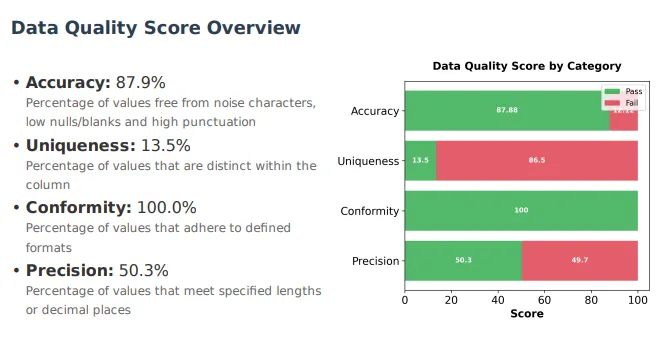Por qué son importantes los perfiles de datos de IA
A todos nos ha pasado. Abres un nuevo conjunto de datos y te das cuenta de que no está tan limpio ni es tan coherente como esperabas. Algunas columnas están vacías, otras tienen caracteres extraños y algunos registros no tienen sentido. Empiezas a desplazarte, a escanear y a cuestionar tus datos. Pasan las horas.
Aquí es donde el perfilado de datos de IA en Match Data Pro lo cambia todo.
En lugar de jugar a los detectives con miles -o millones- de filas, puede obtener al instante una visión general detallada de la salud de sus datos. La IA no sólo analiza su conjunto de datos, sino que también señala exactamente lo que necesita atención antes de pasar a la limpieza, la normalización o la coincidencia difusa.
El problema: los datos erróneos se ocultan a simple vista
Los datos erróneos no sólo son un inconveniente, también son caros.
Los registros de clientes duplicados suponen un gasto inútil en marketing. Las direcciones incompletas pueden hacer que el correo rebote. Los nombres mal escritos pueden hacer que el servicio de atención al cliente parezca impersonal y desconectado.
Y aquí viene lo realmente importante: la mayoría de los problemas de datos no son evidentes hasta que causan problemas. Por ejemplo:
Una columna de direcciones que parece estar bien... hasta que te das cuenta de que la mitad de los códigos postales tienen un dígito de más.
Un campo de número de teléfono que contiene códigos de país a veces, pero no siempre.
Nombres en los que las incoherencias de espaciado o mayúsculas imposibilitan la coincidencia exacta.
Si está comprobando manualmente estos problemas, ya está perdiendo un tiempo valioso.
La solución: Perfiles de datos AI con Match Data Pro
Con Match Data Pro, AI Data Profiling funciona como un microscopio de calidad de datos. Usted carga su conjunto de datos y en cuestión de segundos obtiene un desglose visual y fácil de leer de:
Integridad - Cuántos registros tienen valores que faltan en cada columna.
Coherencia - Si los datos coinciden con los patrones esperados (como los formatos de correo electrónico o la longitud de los números de teléfono).
Unicidad - Detección de valores duplicados o repetidos.
Tipos de datos - Reconocimiento automático de si los campos son de texto, numéricos, fechas o mixtos.
Precisión: información sobre formatos numéricos, decimales y exactitud.
Pero no se limita a señalar los problemas, sino que sugiere los siguientes pasos. La IA recomienda reglas de limpieza específicas y criterios de coincidencia en función de lo que encuentra.
Experiencia personal: De horas a minutos
Antes de incorporar esta función a Match Data Pro, pasábamos horas realizando consultas manuales, exportando a hojas de cálculo y configurando filtros sólo para comprender la magnitud de nuestros problemas de datos.
¿Y ahora? Puedo subir un archivo de un millón de registros y en menos de un minuto ver:
Qué columnas son las más completas
Cuáles son los campos con más errores de formato
Dónde se esconden mis mayores riesgos de duplicación
Qué patrones o valores atípicos podrían afectar a los resultados del emparejamiento difuso
Eso significa que puedo centrar mis esfuerzos en lo que más importa, solucionar los problemas, sin perder tiempo adivinando dónde pueden estar.
Ejemplo real: Preparación de una campaña de correo a gran escala
Imagine que está preparando una lista de direcciones para un mailing nacional. Hay mucho en juego: cada dirección duplicada o incorrecta cuesta dinero y hace que su campaña sea menos eficaz.
Con perfiles de datos de IA:
Cargue la lista en Match Data Pro.
La IA se ejecuta al instante y muestra que en el 15% de las direcciones faltan códigos postales y que el 4% contiene caracteres no válidos.
Detecta patrones en el formato de las direcciones, como algunos registros que utilizan abreviaturas (por ejemplo, "St." frente a "Street") de forma incoherente.
Sugiere acciones de limpieza, como normalizar las abreviaturas y validar los códigos postales.
A continuación, puede utilizar la concordancia difusa para encontrar nombres y direcciones casi duplicados antes de finalizar la lista.
¿Cuál es el resultado? Un archivo de direcciones limpio, estandarizado y deduplicado, listo para la acción.
Cómo ayuda el perfilado de datos de IA a la comparación difusa
La creación de perfiles no sólo ayuda a limpiar los datos, sino que permite realizar correspondencias más precisas. La concordancia difusa funciona mejor cuando los datos son coherentes y completos. Por ejemplo:
Coincidencia difusa de nombres: si la IA observa que algunos nombres contienen espacios de más o mayúsculas incoherentes, puede sugerir reglas de recorte y formato.
Coincidencia difusa de direcciones: si los nombres de las calles tienen abreviaturas incoherentes, la IA las marcará para que pueda estandarizarlas antes de la coincidencia.
Correspondencia entre columnas: la creación de perfiles ayuda a identificar cuándo existe la misma información en varios campos pero en diferentes formatos, lo que facilita la correspondencia entre columnas.
En otras palabras, la creación de perfiles de datos de IA es como poner a punto el motor antes de una carrera: garantiza que todo funcione al máximo rendimiento antes de que comience el verdadero trabajo.
Por qué destaca Match Data Pro
Muchas herramientas pueden crear perfiles de datos, pero el perfil de IA de Match Data Pro se ha creado teniendo en cuenta los flujos de trabajo de coincidencia y limpieza del mundo real. No se limita a mostrarte estadísticas, sino que te guía hacia acciones que mejoran directamente tus resultados.
Algunas ventajas clave:
Diseñado para usuarios técnicos y no técnicos
Trabaja con millones de registros rápidamente
Sugerencias integradas de limpieza y emparejamiento
Totalmente integrado con nuestro motor de concordancia difusa
Una forma mejor de empezar cada proyecto
Si alguna vez ha empezado a realizar una limpieza o un cotejo sin haber perfilado primero los datos, sabrá lo frustrante que es encontrar problemas al final del proceso. Con AI Data Profiling, obtendrá claridad desde el principio, lo que le ahorrará tiempo, mejorará la calidad y reducirá los errores.
En mi propio flujo de trabajo, no toco un conjunto de datos sin hacer antes un perfil. Es como leer un mapa antes de emprender un viaje: sabes dónde están los puntos problemáticos y cómo sortearlos.
Pruébelo usted mismo
Si está listo para tomar el control de la calidad de sus datos, pruebe el perfilado de datos AI de Match Data Pro. Verá exactamente dónde están sus problemas, obtendrá recomendaciones prácticas para solucionarlos y se preparará para la coincidencia más precisa posible.
Sus datos tienen una historia. Deje que AI Data Profiling le ayude a leerla, de forma rápida, clara y con la confianza de que cada decisión se basa en la verdad, no en conjeturas.
Haga clic aquí para inscribirse


